
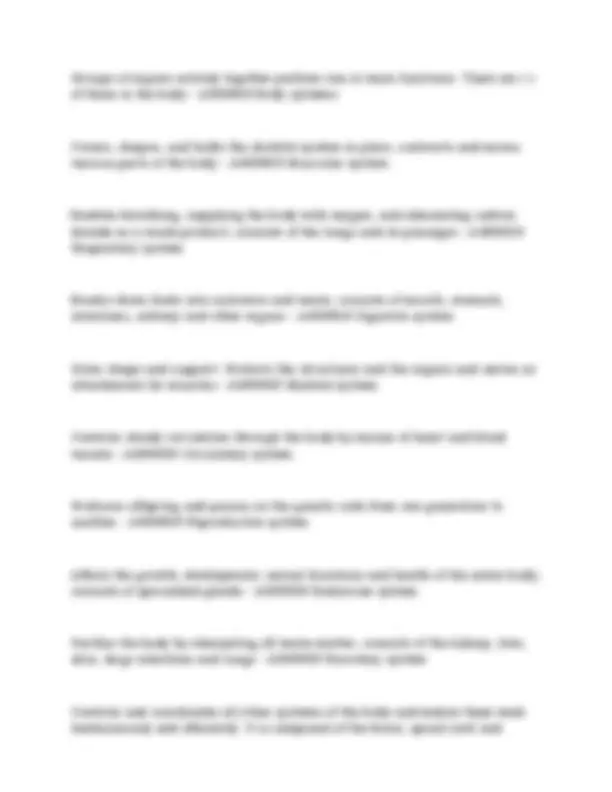
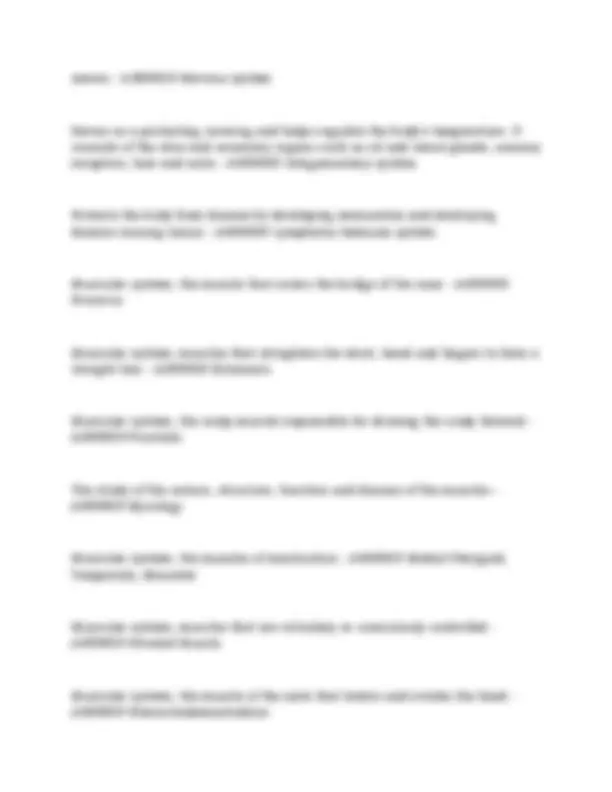
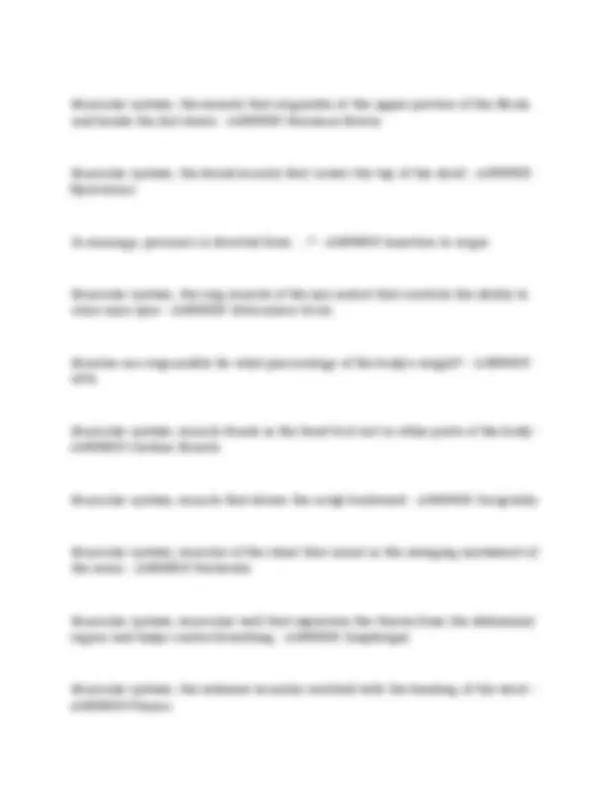
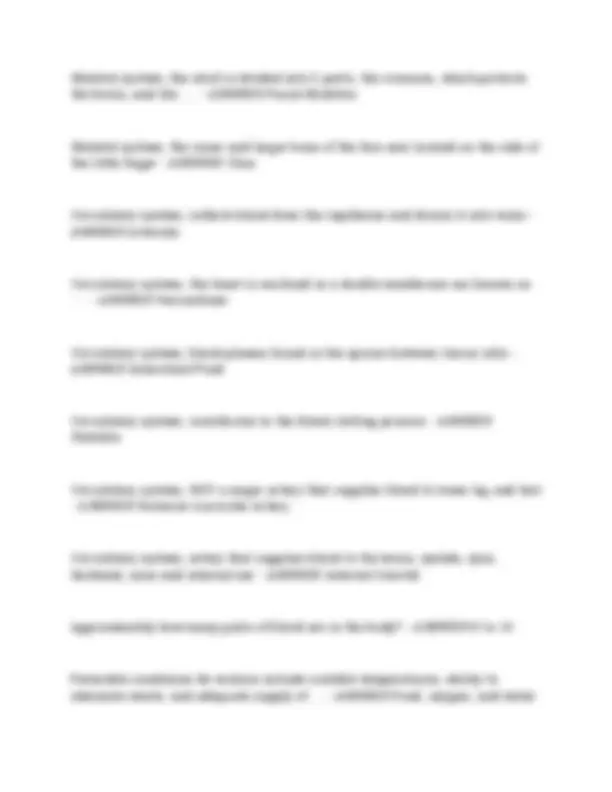
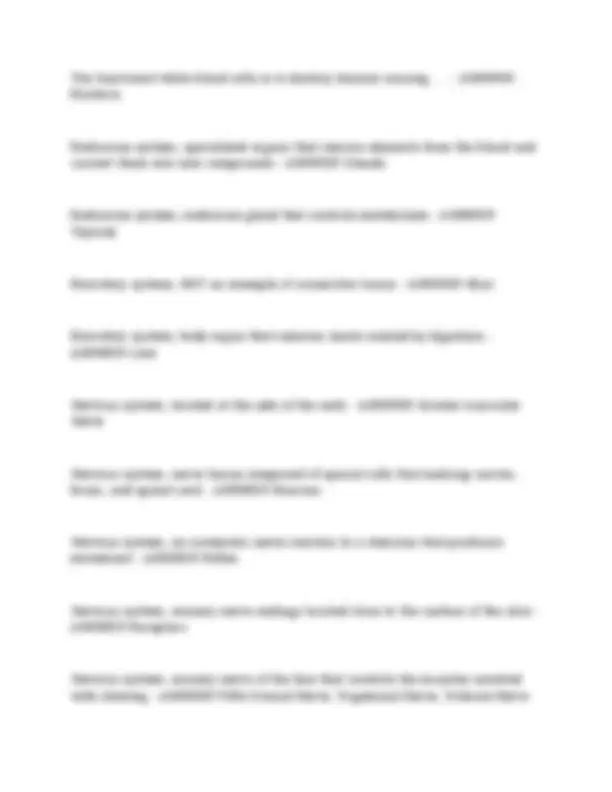
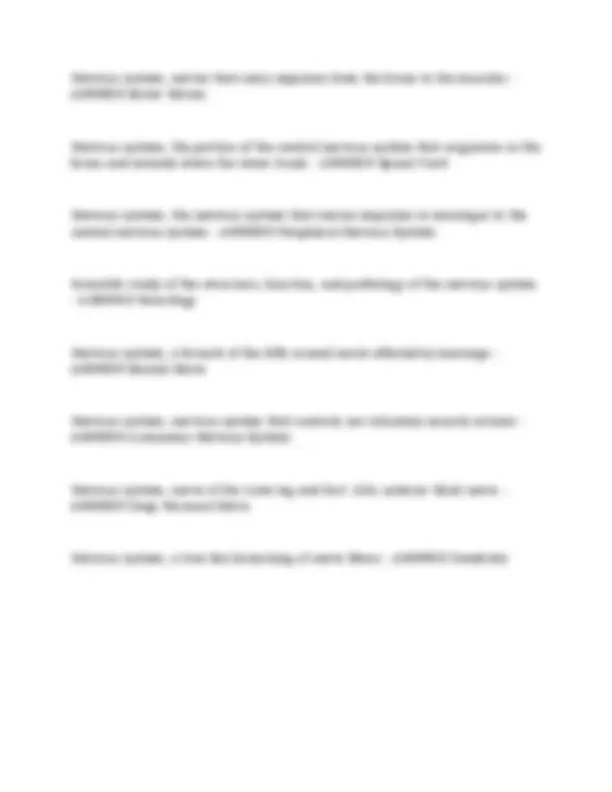


Study with the several resources on Docsity

Earn points by helping other students or get them with a premium plan


Prepare for your exams
Study with the several resources on Docsity

Earn points to download
Earn points by helping other students or get them with a premium plan
Community
Ask the community for help and clear up your study doubts
Discover the best universities in your country according to Docsity users
Free resources
Download our free guides on studying techniques, anxiety management strategies, and thesis advice from Docsity tutors
Cosmetology Anatomy & Physiology With 100% Complete Solutions
Typology: Exams
1 / 10

This page cannot be seen from the preview
Don't miss anything!







Study of the human body and the structures - ANSWER Anatomy
Study of the functions of the body - ANSWER Physiology
Study of tiny structures found in tissues ; AKA microscopic anatomy - ANSWER Histology
Basic unit of all living things - ANSWER Cell
What does the cell structure consist of? - ANSWER Protoplasm, Nucleus, Cytoplasm, Cell membrane
Colorless jellylike substance found in cells - ANSWER Protoplasm
Control center of the cell - ANSWER Nucleus
Surrounds nucleus and is a watery fluid for growth, reproductions, and repair - ANSWER Cytoplasm
Encloses the protoplasm and permits soluble substances to enter and leave the cell - ANSWER Cell membrane
Cell reproduction; when the cell divides into two daughter cells - ANSWER Mitosis
What are the two phases of metabolism? - ANSWER Anabolism and Catabolism
Chemical process that takes place in living organisms through which cells are nourished - ANSWER Metabolism
Process of building up molecules - ANSWER Anabolism
Process of breaking down molecules - ANSWER Catabolism
Fibrous tissue binds together, protects, and supports various parts of the body
Protective tissue such as skin, tissue inside the mouth, digestive and respiratory - ANSWER Epithelial tissue
Contracts and moves various body parts - ANSWER Muscle tissue
Carries messages to and from the brain. Coordinates and controls all bodily functions - ANSWER Nerve tissue
Technical term for fat giving contour to the body - ANSWER Adipose
Structures composing of specialized tissues designed to perform specific functions in plants and animals - ANSWER Organs
nerves - ANSWER Nervous system
Serves as a protecting covering and helps regulate the body's temperature. It consists of the skin and accessory organs such as oil and sweat glands, sensory receptors, hair and nails - ANSWER Integumentary system
Protects the body from disease by developing immunities and destroying disease causing toxins - ANSWER Lymphatic/Immune system
Muscular system; the muscle that covers the bridge of the nose - ANSWER Procerus
Muscular system; muscles that straighten the wrist, hand and fingers to form a straight line - ANSWER Extensors
Muscular system, the scalp muscle responsible for drawing the scalp forward - ANSWER Frontalis
The study of the nature, structure, function and disease of the muscles - ANSWER Mycology
Muscular system; the muscles of mastication - ANSWER Medial Pterygoid, Temporalis, Masseter
Muscular system; muscles that are voluntary or consciously controlled - ANSWER Striated Muscle
Muscular system; the muscle of the neck that lowers and rotates the head - ANSWER Sternocleidomastoideus
Muscular system; the muscle that originates at the upper portion of the fibula and bends the foot down - ANSWER Peroneus Brevis
Muscular system; the broad muscle that covers the top of the skull - ANSWER Epicranius
In massage, pressure is directed from ...? - ANSWER Insertion to origin
Muscular system; the ring muscle of the eye socket that controls the ability to close ones eyes - ANSWER Orbicularis Oculi
Muscles are responsible for what perrcentage of the body's weight? - ANSWER 40%
Muscular system; muscle found in the heart but not in other parts of the body - ANSWER Cardiac Muscle
Muscular system; muscle that draws the scalp backward - ANSWER Occipitalis
Muscular system; muscles of the chest that assist in the swinging movement of the arms - ANSWER Pectoralis
Muscular system; muscular wall that separates the thorax from the abdominal region and helps control breathing - ANSWER Diaphragm
Muscular system; the extensor muscles involved with the bending of the wrist - ANSWER Flexors
Skeletal system; the largest bone of the arm, extending down from the elbow to the shoulder - ANSWER Humerus
Skeletal system; forms the kneecap joint - ANSWER Patella
The study of anatomy, structure, and function of the bones - ANSWER Osteology
Skeletal system; the flay bone that forms the ventral support of the ribs - ANSWER Sternum
Skeletal system; the U-shaped bone at the base of the tongue that supports the tongue and its muscles - ANSWER Hyoid Bone
The muscular is one of these - ANSWER Toe Phalanges
Skeletal system; the connection between 2 or more bones of the skeleton - ANSWER Joint
What does not compose the ankle joint? - ANSWER Femur
Skeletal system; with exception of the teeth, hardest tissue in the body - ANSWER Bone
Skeletal system; small, thin bones lscted at the inner wall of the orbits - ANSWER Lacrimal Bones
Skeletal system; the skull is divided into 2 parts, the cranium, which protects the brain, and the .... - ANSWER Facial Skeleton
Skeletal system; the inner and larger bone of the fore arm located on the side of the little finger - ANSWER Ulna
Circulatory system; collects blood from the capillaries and drains it into veins - ANSWER Arteriole
Circulatory system; the heart is enclosed in a double membrane sac known as .... - ANSWER Pericardium
Circulatory system; blood plasma found in the spaces between tissue cells - ANSWER Interstitial Fluid
Circulatory system; contributes to the blood clotting process - ANSWER Platelets
Circulatory system; NOT a major artery that supplies blood to lower leg and foot
Circulatory system; artery that supplies blood to the brain, eyelids, eyes, forehead, nose and internal ear - ANSWER Internal Carotid
Approximately how many pints of blood are in the body? - ANSWER 8 to 10
Favorable conditions for mitosis include suitable temperatures, ability to eliminate waste, and adequate supply of ... - ANSWER Food, oxygen, and water
Nervous system; nerves that carry impulses from the brain to the muscles - ANSWER Motor Nerves
Nervous system; the portion of the central nervous system that originates in the brain and extends down the lower trunk - ANSWER Spinal Cord
Nervous system; the nervous system that carries impulses or messages to the central nervous system - ANSWER Peripheral Nervous System
Scientific study of the structure, function, and pathology of the nervous system
Nervous system; a branch of the fifth cranial nerve affected by massage - ANSWER Mental Nerve
Nervous system; nervous system that controls are voluntary muscle actions - ANSWER Autonomic Nervous System
Nervous system; nerve of the Lowe leg and foot. AKA anterior tibial nerve - ANSWER Deep Peroneal Nerve
Nervous system; a tree-like branching of nerve fibers - ANSWER Dendrites